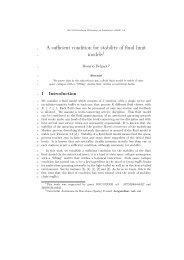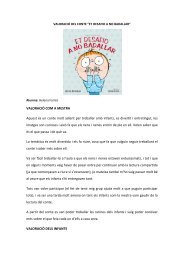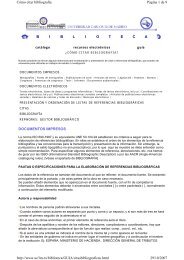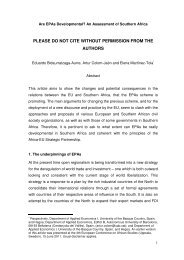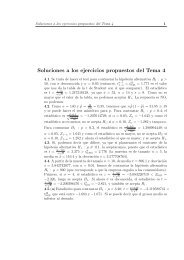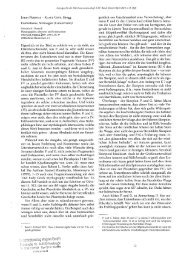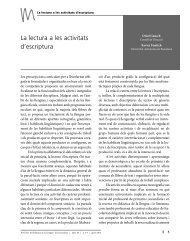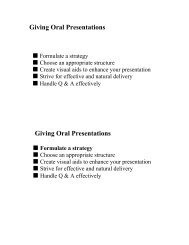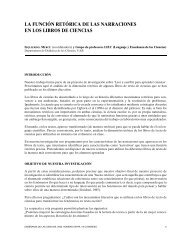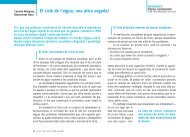J. Theor. Biol. 2006 - PÃ gines de la UAB
J. Theor. Biol. 2006 - PÃ gines de la UAB
J. Theor. Biol. 2006 - PÃ gines de la UAB
- No tags were found...
You also want an ePaper? Increase the reach of your titles
YUMPU automatically turns print PDFs into web optimized ePapers that Google loves.
254<br />
ARTICLE IN PRESS<br />
J.F. Fontanari et al. / Journal of <strong>Theor</strong>etical <strong>Biol</strong>ogy 239 (<strong>2006</strong>) 247–256<br />
Ω m<br />
1<br />
0.8<br />
0.6<br />
0.4<br />
0.2<br />
1<br />
0<br />
0 0.05 0.1 0.15 0.2<br />
u<br />
Fig. 9. Fraction of vesicles carrying m ¼ 0, 2 and 2 uncorrupted temp<strong>la</strong>te<br />
types as a function of the mutation probability for d ¼ 2, N ¼ 20, t ¼ 0:1<br />
and g ¼ 0:5.<br />
u c<br />
1<br />
0.8<br />
0.6<br />
0.4<br />
0.2<br />
expense of the vesicles carrying the two types (m ¼ 2).<br />
Vesicles carrying only error-tail temp<strong>la</strong>tes (m ¼ 0) become<br />
common for <strong>la</strong>rger values of the mutation probability. The<br />
fact that both fractions O 1 and O 2 vanish simultaneously at<br />
a single threshold value is easily un<strong>de</strong>rstood. According to<br />
Eq. (1), vesicles <strong>la</strong>cking one or more uncorrupted temp<strong>la</strong>te<br />
type are assigned the baseline survival probability, and so<br />
group selection is turned off when the vesicles with m ¼ d<br />
uncorrupted temp<strong>la</strong>te types are extinct. Since we have<br />
already argued that in the absence of group selection<br />
uncorrupted temp<strong>la</strong>tes cannot be maintained in vesicles of<br />
finite capacity, the vesicles with mod must die out too. In<br />
fact, the <strong>de</strong>pen<strong>de</strong>nce of the critical mutation probability on<br />
the group selection pressure, <strong>de</strong>picted in Fig. 10, reinforces<br />
this point (though for a rather low vesicle capacity N ¼ 6),<br />
since for go0:18 group selection is overcome by drift (see<br />
Fig. 2), the coexistence of the two uncorrupted temp<strong>la</strong>te<br />
types is impossible and so they are lost in the presence of a<br />
vanishing small mutation probability.<br />
2<br />
0.9<br />
0.5<br />
0<br />
0 0.2 0.4 0.6 0.8 1<br />
g<br />
Fig. 10. Critical value of the mutation probability u c above which the<br />
uncorrupted temp<strong>la</strong>tes are lost as a function of the group selection<br />
pressure g for d ¼ 2, N ¼ 6 and t ¼ 0:1; 0:5 and 0.9.<br />
0.1<br />
0<br />
5. Conclusion<br />
Consi<strong>de</strong>r the standard scenario of pre-biotic evolution: a<br />
popu<strong>la</strong>tion of temp<strong>la</strong>tes (or even a more e<strong>la</strong>borate system<br />
of coupled temp<strong>la</strong>tes, such as the hypercycle) whose<br />
imperfect replication accuracy produces inefficient and<br />
useless temp<strong>la</strong>tes, the error tail, with back-mutations not<br />
allowed, as usual. Then confine this popu<strong>la</strong>tion to a vesicle<br />
of finite capacity, an often quoted ‘‘next’’ step (cf. Maynard<br />
Smith and Szathma´ry, 1995) towards the evolution of more<br />
complex organisms. The stage for a catastrophe is set, since<br />
c<strong>la</strong>ssical popu<strong>la</strong>tion genetics tells us that sooner or <strong>la</strong>ter the<br />
useful temp<strong>la</strong>tes will be lost due to random genetic drift—a<br />
fate the temp<strong>la</strong>tes in the error tail are spared due to the rare<br />
but recurrent mutation events. The solution to this<br />
conundrum is to admit that the vesicles have a dynamics<br />
of their own, which may be affected by their particu<strong>la</strong>r<br />
temp<strong>la</strong>te compositions, resulting in a new selection<br />
pressure—group selection. This view accords with a setting<br />
where metabolic life (i.e. a popu<strong>la</strong>tion of vesicles capable of<br />
growth and reproduction) thrived before the appearance of<br />
temp<strong>la</strong>tes, i.e. the metabolism-first hypothesis. As repeatedly<br />
pointed out in the literature (see, e.g. Dyson, 1985;<br />
Ga´nti, 1987, 2003), heredity and, consequently, Darwinian<br />
evolution are not necessary and must not be invoked at this<br />
metabolic stage; although it is not clear at all what perils<br />
are in store for such hypothetical popu<strong>la</strong>tions of metabolic<br />
vesicles.<br />
In this paper, we investigated quantitatively the strength<br />
of the group selection necessary to counterba<strong>la</strong>nce the<br />
intra-group disintegration pressures of mutation, competition<br />
and drift, and so guarantee the coexistence of a few<br />
different temp<strong>la</strong>te types in a same vesicle. The formalism<br />
employed here builds on the work of Aoki (1982) (see also<br />
Boorman and Levitt, 1980; Eshel, 1972; Levin and Kilmer,<br />
1974) on the evolution and maintenance of altruistic traits.<br />
In particu<strong>la</strong>r, it is assumed that there are an infinite number<br />
of vesicles, each of which occupied by a finite number N of<br />
temp<strong>la</strong>tes. This assumption allows us to write a set of<br />
recursion equations for the frequencies of the vesicle types<br />
in the popu<strong>la</strong>tion. Due to the <strong>la</strong>rge combinatorial number<br />
of all possible vesicle compositions, this approach is<br />
feasible for at most d ¼ 4 temp<strong>la</strong>te types and vesicle<br />
capacity No100. We note, however, that most quantitative<br />
studies of package mo<strong>de</strong>ls have concentrated on the<br />
coexistence of only two temp<strong>la</strong>te types. The advantage of<br />
this approach is that we can fully explore the space of the<br />
control parameters (except for d and N) and so <strong>de</strong>termine<br />
with certainty the critical values of the parameters that<br />
<strong>de</strong>limitate the regions in that space where temp<strong>la</strong>te<br />
coexistence is possible or not. Rather surprisingly, we find<br />
no fundamental impediment to the coexistence of an<br />
arbitrary number of temp<strong>la</strong>te types dpN, provi<strong>de</strong>d the<br />
group selection pressure is sufficiently strong. This is in<br />
stark contrast with the findings for the hypercycle, for<br />
which no matter the strength of the kinetic constants<br />
associated to the catalysis between consecutive temp<strong>la</strong>tes,




